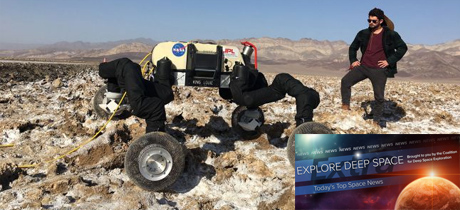In Today’s Deep Space Extra… NASA takes more steps to prepare for the return of human explorers to the surface of the Moon in 2024 and prepare for Mars. Canadian study suggests lunar water could have high economic value.
Human Space Exploration
Alabama space center will manage NASA’s lunar lander program
Ars Technica (8/13): The publication offers a preview of NASA Artemis field center assignments possible this Friday as NASA Administrator Jim Bridenstine visits the Marshall Space Flight Center. Citing congressional sources, Ars Technica reports Marshall will lead overall efforts by NASA to develop a Moon lander and two of its three elements, the Transfer and Descent stages that will descend from a lunar orbiting, human tended Gateway. The Johnson Space Center (JSC), which manages the Gateway, will manage development of the lander’s ascent stage, which will provide a surface habitat for the astronauts as well as quarters during the descent and ascent from and to the Gateway.
Space Science
Space samples link NASA’s Apollo 11 and Mars 2020
NASA Jet Propulsion Laboratory (8/13): Apollo 11, which recently marked its 50th anniversary, raised the bar when it came to planetary science as well as human space exploration as it landed on the Moon with two astronauts, who then collected lunar rocks and soil and brought them back to Earth. NASA’s Mars 2020 rover, set to launch next July/August and touch down at Jezero Crater on Mars in February 2021, will attempt to extend the tradition. The rover will gather and cache samples of soil and rock from what looks to be once habitable environments. NASA and the European Space Agency (ESA) are collaborating on a pair of follow up missions to retrieve the samples and return them to Earth.
Chandrayaan-2 leaves earth’s orbit, moving towards Moon
Deccan Herald of India (8/14): Launched July 22, India’s Chandrayaan-2 mission to the Moon’s south pole has departed the Earth orbit phase and entered the desired trans lunar trajectory. The spacecraft is on a course to touchdown with a rover on September 7, Indian time.
Watch NASA’s ‘LEMUR’ robot climb a cliff in Death Valley as practice for Mars
Space.com (8/13): LEMUR, or the NASA Jet Propulsion Laboratory’s Limbed Excursion Mechanical Utility Robot, was originally envisioned as a robotic assistant for work outside the International Space Station (ISS). Now, though, LEMUR is being groomed for exploration activities on Mars or other far off planetary destinations. Earlier this year, LEMUR participated in a Death Valley, California, field test.
Astronomers uncover dozens of previously unknown ancient and massive galaxies
Universe Today (8/12): A multinational Japanese led team of astronomers has discovered 39 star systems that date to the first two billion years of the universe using an assortment of global observatories known as the Atacama Large Millimeter/submillimeter Array. The findings, published in the journal Nature, may help to enrich an understanding of dark matter and the evolution of super massive black holes.
Other News
Mining water on the Moon economic study estimates value at $206 billion over 30 years
SpaceQ of Ontario Canada (8/8): The long term value of water extracted from ice deposits at the Moon is estimated at $206 billion over three decades by Watts, Griffis and McOuat Limited, Toronto based geological and mining consultants. Potential applications range from a Moon base and Mars space station to the refueling of spacecraft in low Earth orbit.
Spacecraft gyroscopes and reaction wheels. You can never have enough
Space.com (8/13): Like magic, reaction wheels and gyroscopes point and steady a range of spacecraft without the overhead of thrusters and propellant. However, as with most machinery they are susceptible to wear and tear over time.

